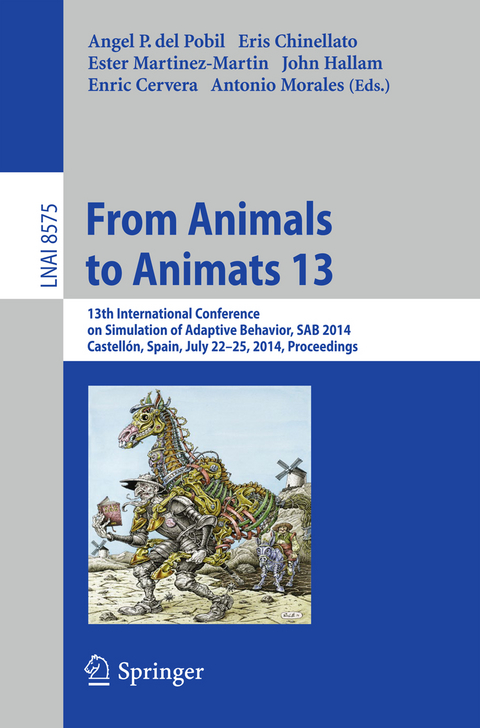
From Animals to Animats 13
Springer International Publishing (Verlag)
978-3-319-08863-1 (ISBN)
Animat Approach and Methodology.- A Role for Sleep in Artificial Cognition through Deferred Restructuring of Experience in Autonomous Machines.- Time in Consciousness, Memory and Human-Robot Interaction.- Non-representational Sensorimotor Knowledge.- Perception and Motor Control.- Self-exploration of the Stumpy Robot with Predictive Information Maximization.- Detecting the Vibration in the Artificial Web Inspired by the Spider.- Modelling Reaction Times in Non-linear Classification Tasks.- Multiple Decoupled CPGs with Local Sensory Feedback for Adaptive Locomotion Behaviors of Bio-inspired Walking Robots.- Poramate Manoonpong.- The Role of a Cerebellum-Driven Perceptual Prediction within a Robotic Postural Task.- Biomimetic Agent Based Modelling Using Male Frog Calling Behaviour as a Case Study.- Navigation and Internal World Models Snapshot Homing Navigation Based on Edge Features.- Ground-Nesting Insects Could Use Visual Tracking for Monitoring Nest Position during Learning Flights.- Adaptive Landmark-Based Navigation System Using Learning Techniques.- Robustness Study of a Multimodal Compass Inspired from HD-Cells and Dynamic Neural Fields.- Learning and Adaptation.- Developmental Dynamics of RNNPB: New Insight about Infant Action Development.- Simulating the Emergence of Early Physical and Social Interactions: A Developmental Route through Low Level Visuomotor Learning.- Intrinsically Motivated Decision Making for Situated, Goal-Driven Agents.- An Anti-hebbian Learning Rule to Represent Drive Motivations for Reinforcement Learning.- Unsupervised Learning of Sensory Primitives from Optical Flow Fields.- Reinforcement-Driven Shaping of Sequence Learning in Neural Dynamics.- Rapid Humanoid Motion Learning through Coordinated, Parallel Evolution.- Evolution.- Programmable Self-assembly with Chained Soft Cells: An Algorithm to Fold into 2-D Shapes.- Voxel Robot: A Pneumatic Robot with Deformable Morphology.- Task-Driven Evolution of Modular Self-reconfigurableRobots.- A Bacterial-Based Algorithm to Simulate Complex Adaptive Systems.- Online Evolution of Deep Convolutional Network for Vision-Based Reinforcement Learning.- Collective and Social Behavior.- A Swarm Robotics Approach to Task Allocation under Soft Deadlines and Negligible Switching Costs.- Supervised Robot Groups with Reconfigurable Formation: Theory and Simulations.- Coupling Learning Capability and Local Rules for the Improvement of the Objects' Aggregation Task by a Cognitive Multi-Robot System.- Honeybee-Inspired Quality Monitoring of Routing Paths in Mobile Ad Hoc Networks.- Human Inspiration and Comparison for Monitoring Strategies in a Robotic Convoy Task.- Animal Social Behaviour: A Visual Analysis.- Crowd Emotion Detection Using Dynamic Probabilistic Models.
| Erscheint lt. Verlag | 4.8.2014 |
|---|---|
| Reihe/Serie | Lecture Notes in Artificial Intelligence | Lecture Notes in Computer Science |
| Zusatzinfo | XII, 340 p. 144 illus. |
| Verlagsort | Cham |
| Sprache | englisch |
| Maße | 155 x 235 mm |
| Gewicht | 539 g |
| Themenwelt | Mathematik / Informatik ► Informatik ► Datenbanken |
| Informatik ► Grafik / Design ► Digitale Bildverarbeitung | |
| Informatik ► Software Entwicklung ► User Interfaces (HCI) | |
| Informatik ► Theorie / Studium ► Algorithmen | |
| Informatik ► Theorie / Studium ► Künstliche Intelligenz / Robotik | |
| Schlagworte | Algorithm analysis and problem complexity • Cognitive Robotics • human robot interaction • mobile ad hoc networks • Multi-agent Systems • Neural networks • Reinforcement Learning • Robotics • Self-Organization • Simulation • vision for robotics |
| ISBN-10 | 3-319-08863-7 / 3319088637 |
| ISBN-13 | 978-3-319-08863-1 / 9783319088631 |
| Zustand | Neuware |
| Haben Sie eine Frage zum Produkt? |
aus dem Bereich


